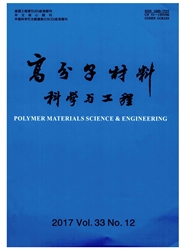

 中文摘要:
中文摘要:
首次采用非线性等转化率法研究了聚苯乙烯在氮气中不同升温速率下的非等温热重曲线,通过程序拟舍得到了热解过程中活化能Eα与转化率α的关系。实验结果显示,在氮气中聚苯乙烯存在一个失重阶段,起始热解温度随升温速率的增大而升高。动力学拟合结果显示,热解初始阶段的活化能值较低,约为80kJ/mol,主要对应于聚合物链中弱键的任意断裂反应,其反应速度很快;随着反应的进行,活化能Eα逐渐增大,当α〉0.3后趋于平缓,此阶段Eα的平均值约为145kJ/mol,反应主要为聚合物链本身的断裂、解聚;当α〉0.9时,Eα值迅速减小,反应以链终止反应为主。
 英文摘要:
英文摘要:
The relationship of energy Eα and conversion rate a in the degradation process of polystyrene was first studied by nonlinear iso-conversional methods. There is a weight loss stage for polystyrene degradation in N2 and the starting temperature increase at high heating rate. The kinetic analysis results indicate that at the initial stage of polystyrene degradation, the activation energy E, is 80 kJ/mol, which suggests that the initial weight loss is most likely to be associated with the cleavage of weak linkages in polystyrene molecules. The concentration of the weak linkages decreases with the extent of degradation. As a result, the activation energy Eα increases rapidly. As a α〉0.3, the Eα does not have a significant change and the value is around 145 kJ/mol, which reflects the cleavage and unzipping reaction of main chain. As α 〉 0.9, the decrease of Eα value is associated with the chain termination reactions.
 同期刊论文项目
同期刊论文项目
 同项目期刊论文
同项目期刊论文
 期刊信息
期刊信息
